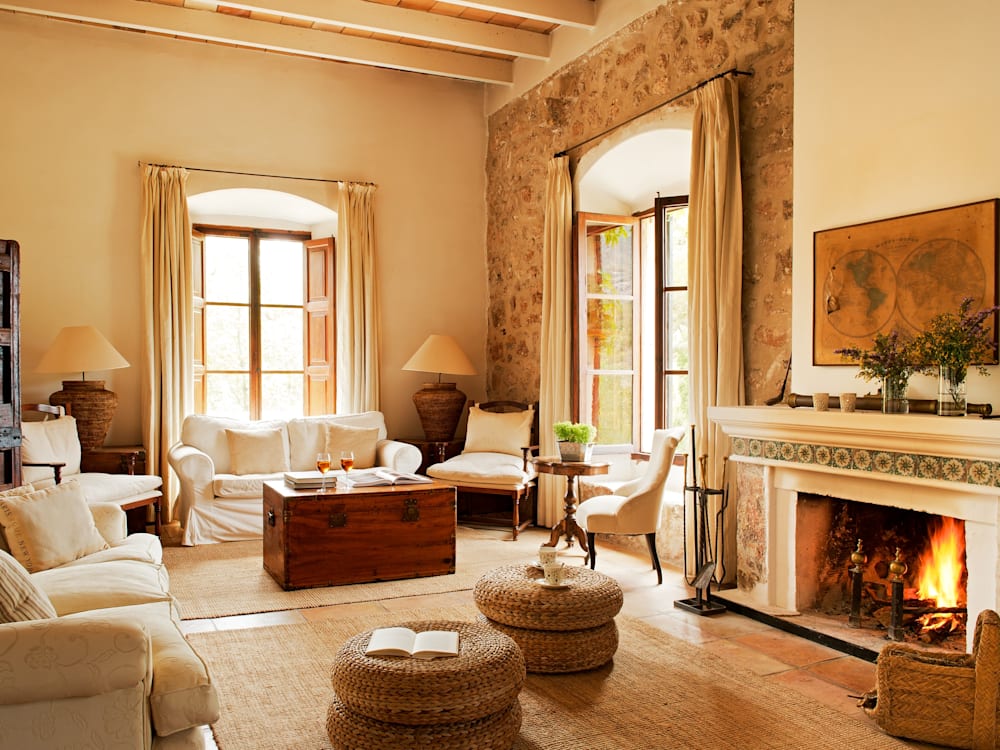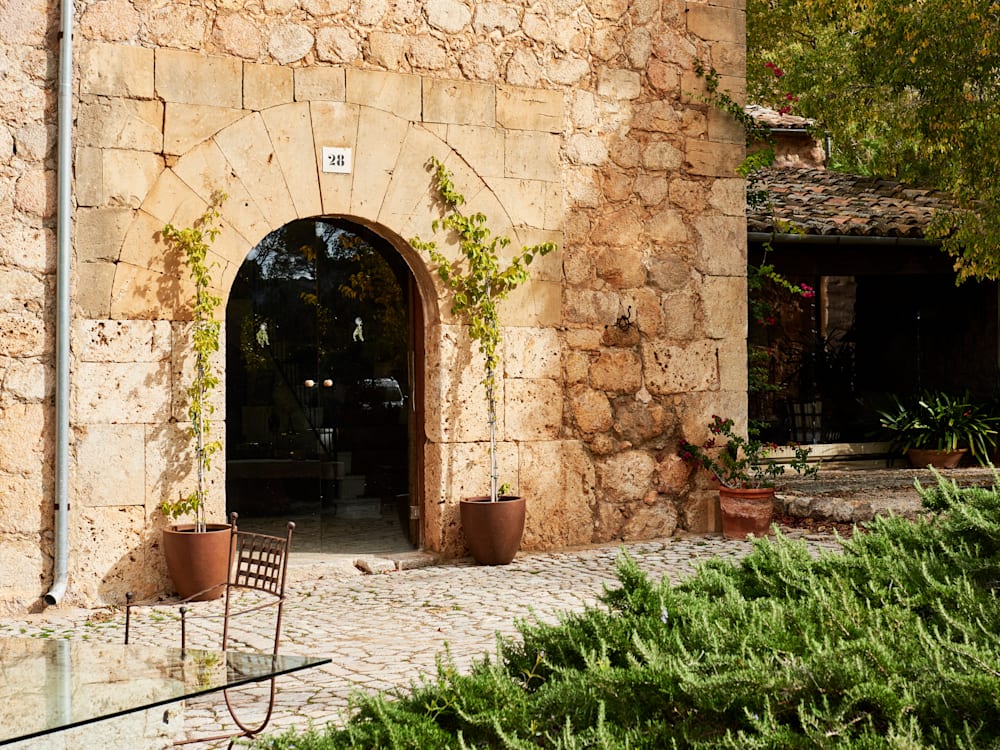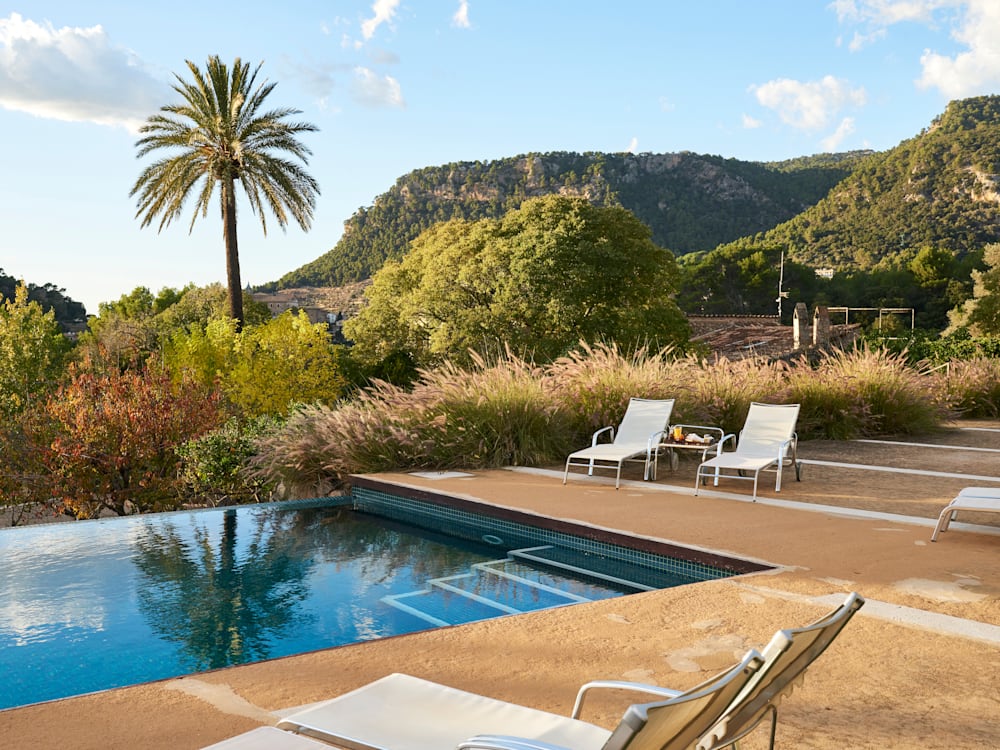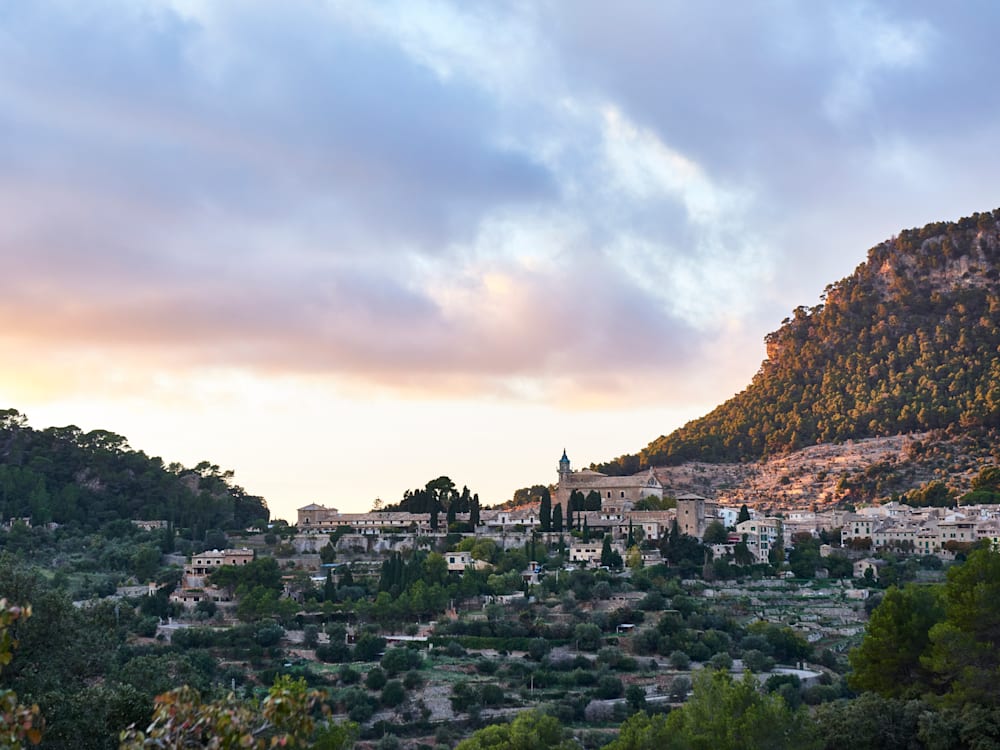We pass the centuries-old capital, and drive through flatlands where old windmills are a souvenir from this Balearic island’s past. Rising up into the jagged hills through giant crevices – cliffs rising and tumbling before us – it isn’t long before we’re turning off the main road, up a dirt track to our boutique abode.
Steep and rocky, it reminds us of when we almost swerved off the Pacific Coast Highway 1 in California in a Mustang convertible. Our taxi may be distinctly less glamorous but it’s proving decidedly less stressful on such terrain, and we creep round the last bend in the track to be greeted by the beautiful, simple façade of Mirabó de Valldemossa.
A long farmhouse in old, large stone with dark wood shutters, it’s smothered in a sweet-smelling jasmine. Antonio, a darling gentleman, greets us and whisks away our bags, then escorts us through the large oak doors into the understated entrance of this former olive press.
The high-ceilinged living room is grand yet simple, sophisticated but soothing, comfortable and inviting, and we mentally reserve seats by the double fireplace for a nightcap, and the scene from the windows reminds us why the hotel’s name translates as ‘View of Valldemossa’.

A quick snoop in the honesty bar, originally the farmhouse’s kitchen we assume, and we scribble our choices for supper later. The menu is simple: starters and mains with local flavours and ingredients.
We’re not staying in the main house, so we pass through the original pressing room on the way to the garden. Some 200 years on, the vast iron-screw-and-stone vat now dominates an intimate dining room. En route to our suite, we pass a small hidden cabin, or figuera, surrounded by evergreen bushes and flanked by a large fig tree.
A well-laid path snakes us along the outer wall of this small estate and up to Porche de las Ovejas (‘the sheep hut’), which sits above the main house. Our romantic bolthole has been cleverly built into the wall of the terrace and a large north-west-facing window looks across to the mediaeval town of Valldemossa.

Geometric lines and floor-to-ceiling windows make the bedroom feel modern, while the character and charm of this private hideaway is all intact. Large shutters swing open to greet us with a big white bed backdropped by a curved stone wall. Two white-upholstered oak rocking chairs and a huge matching ottoman are positioned in front of the glass wall, guaranteeing a grandstand view of the ancient mountainscape.
Mr Smith is always one to comment about a new room – and in most cases what’s wrong about it. He says nothing. Complete and utter silence; it’s the ultimate compliment.
Unpacked, and swimmers on, we wander across to the pool. Here clean architectural lines – from the terraced wall, to the freshly cut lawn – frame the most brilliant turquoise tiled pool. We notice a second smaller plunge pool, a boon if you fancy private time away from other guests. And swinging gently under the branches of another mature fig tree is a hammock, which is perfect for late-afternoon lounging.

Dining here is as formal or informal as you want it to be. We soak up the sights and the fragrant smells of this hilltop retreat as we amble down to eat at 8.30pm. In summer, the sun stays high for much of the early evening, setting suddenly at 9.30pm. The restaurant caters to guests only, and one glance tells you immediately: that doesn’t include children.
The elegant porch dining area is almost full when we arrive, and Madame Butterfly is the soft soundtrack behind the hushed chattering and the gentle patter of cutlery on china. As our previous evening in London was spent enjoying the visual feast that is Anthony Minghella’s take on the Puccini opera, the music gives us an extra thrill.
Spotting two large sturdy glass-topped tables, canopied beneath a fig tree, we ask if we can sit there. Neither is made up for dinner; Antonio gasps, then smiles, happily making our wish his command.
Taking our drinks to the north-west-facing front of the house, it feels as though we’re in our own theatre. It feels as though we’re waiting for the bell that signals the end of the first act. Except this is a private performance and the only hum around us is of birds and a whistle of the leaves.
Then the curtain rises and the drama restarts: our starters arrive. Buffalo mozzarella, tomatoes and basil and a bottle of chilled rosé – it’s all delicious and refreshing. Next, lamb that falls from the bone is placed in front of me, fresh prawns across the table for Mr Smith. It’s already standing-ovation-worthy stuff, then, as the light fades, the candlelight and stars take centre stage in this uncensored showcase from nature.

The following morning, a dip in the pool is a prelude to a simple but substantial breakfast of eggs, breads, cold cuts, cereals, fresh juice and fruits. Of course we opt for our own personal table by the lavender garden. Knowing lunch won’t be served here later, we take the chance to visit postcard-pretty, historical Deià.
The mountain coastline leading to this charming ancient town recalls Big Sur in California. It’s worth the trip, although the return journey is a little time-consuming. Perhaps Valldemossa might have been better for a bite – we couldn’t bear not maximising our time at our beloved Mirabó.
Relaxing by the pool is the headline act of our afternoon. As the heat and sun intensifies, the birds settle and most activity grinds to a halt. A cool breeze from the sea moves slowly through the gap in the mountains.
I lie on my own by the pool, my daydreaming drifting to a wonderful idea. I’d love to take this house for a week with friends: it’s perfectly isolated, perfectly decorated and perfectly inspired by that mirabó of Valldemossa. Let’s hope it’s a scene that comes true – what a fantastic final act that would make.
This review was first published back in 2009 so some hotel details are certain to have changed.
If hats were a country, then Philip Treacy OBE would be royalty. As a child in the west of Ireland, he was obsessed with his mother’s sewing machine, and eventually studied for an MA in fashion design at the Royal College of Art. He went on to design hats for Lagerfeld at Chanel, Gianni Versace, Valentino and Alexander McQueen, winning five British Fashion Designer of the Year awards in the process.

